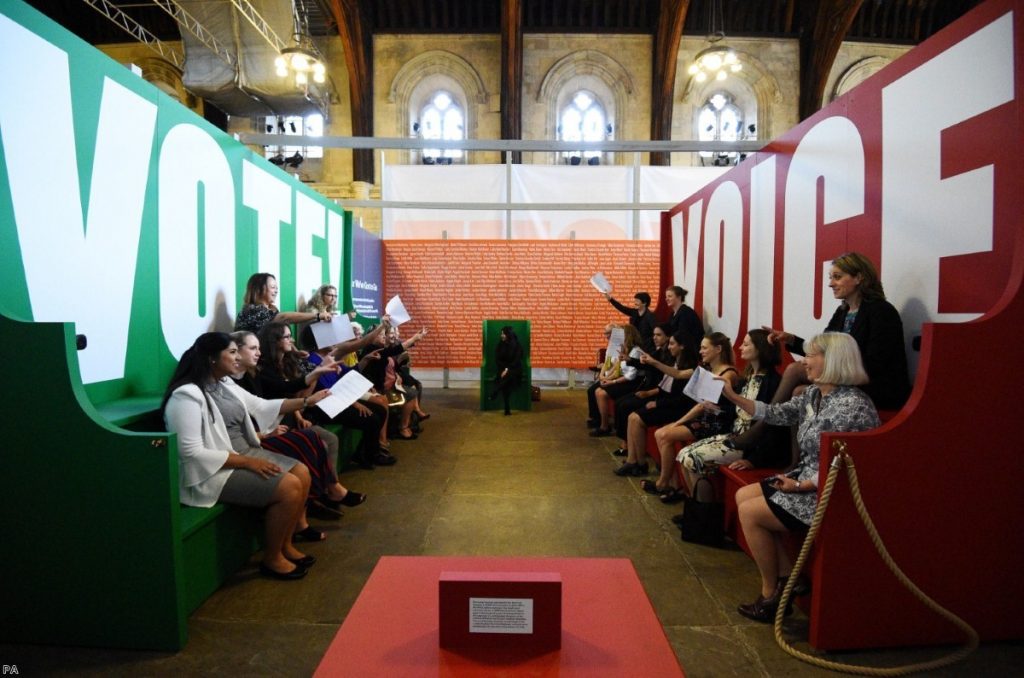By Natalie Bennett
There's been a lot of focus this year on one event, the 100th anniversary of some women getting the vote. It's obviously hugely important, but a conference last week looked at another crucial feminist moment of 1918 which is far less celebrated: the passing of the Parliament (Representation of Women) Act, that guaranteed women could stand for election.
This was actually a far more liberal act, one that should be celebrated as one of the first pieces of true equal rights legislation. For while suffrage was unequal – all men over the age of 21 got the vote, but for women, the age threshold was 30 and there was a property qualification – the right to stand was exactly equal.
So in 1918 women faced the curious circumstance that significant numbers of them were eligible to stand at MPs while still not being eligible to vote.


It must have been a baffling development. Mari Takayanagi of the UK Parliament Vote 100 project, has an interesting take on it. She found that MPs were determined to see that the number of women voters didn't outnumber the men – a clear possibility if you'd equalised the franchise right after the slaughter of the First World War. But it didn't even seem to have occurred to anyone that there might be a possibility of the number of women MPs outnumbering the men.
Even the most pessimistic women'-rights campaigner probably wouldn't have predicted that 100 years later that would still be the case. The proportion of female MPs has crawled to almost 32%, leaving Britain miles down the global league tables.
Early pioneering female MPs found their life to be lonely, the space alienating, the natives profoundly hostile. The first woman to take her seat, Nancy Astor, said in 1923 that "pioneers may be picturesque figures but they are often lonely ones". Even Winston Churchill strongly disapproved of the female presence.
A British Library oral history project charted how long that hostility continued. Current and recently retired female MPs tell us it continues to this day. There has never been a female Tory representative from Wales at Westminster and until very recently they've also been scarce in the other parties.
Women ministers got largely pigeonholed into 'female' roles. For long decades there was apparently space for only one at a time. It was not until 1968 that there were two women in Cabinet simultaneously. And even then, there was a limit to the kinds of jobs they were offered.
Barbara Castle, Judith Hart and Claire Short all got pigeonholed into international development, distinctly regarded by Labour as a 'helping' and 'charitable' role.
Jacqui Smith (Labour, Redditch, 1997-2010), told the conference that the reality is obviously much more complex. Women MPs were generally braver, prepared to take on the difficult tasks and issues, to "stick their head above the parapet".
The practical barriers continue to be formidable. Research has found it hard to identify exactly when MP Lady Tweedsmuir had her baby, but days after coming out of hospital she was dragged into the House for a crucial vote. It was duly won by one and the headline was "held together by a nappy pin". Not much has changed. Smith expressed horror that parliament was still wrangling about the possibility of introducing parental leave.
Were Astor to walk in today, she might appreciate the fact there are now more women's loos, and that the shooting range has gone while a creche has come in. But it would still be an environment in which she was a just-tolerated minority. The statues in the halls and historical paintings on the walls are all filled with images of dead white men. It would all be entirely familiar.
Parliament is a hardly-changed building, containing a little-changed culture and functioning according to a barely-reformed constitutional framework. While the average national constitution around the world lasts 16 years, there's been no significant change in the Commons since 1918, and no major change in the Lords since 1958, when women got in there.
This was a historical conference, but it also pointed to the present and future. Our politics is clearly in chaos, and while individuals clearly bear their share of responsibility (yes that's you Boris Johnson), this is chiefly a result of the structural stasis. With 68% of the votes in the last election not counting and with many MPs seated comfortably for life in 'safe' constituencies, this is still not a properly functioning democracy.
Wale has a lack of female MPs under Westminster's first-past-the-post system, but it saw the first balanced national elected body under the Assembly. They were elected, of course, through a proportional electoral system, under which women generally get better representation.
The UK needs to think long and hard about how it can and should be governed, how it can move out of a creaking early 20th century frame and into the 21st century. That's crucial for equality, democracy, and the basic ability to govern ourselves – and to finally deliver on the high expectations of those brave women pioneers in parliament.
An exhibition Voice and Vote: Women’s Place in Parliament, is open now in Westminster Hall: tickets (free) available here. Twitter provides a narrative of the conference.
Natalie Bennett is the former leader of the Green party.
The opinions in politics.co.uk's Comment and Analysis section are those of the author and are no reflection of the views of the website or its owners.

